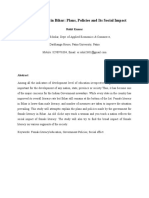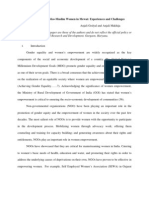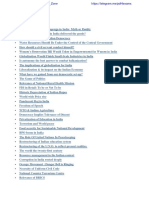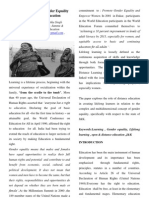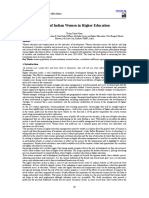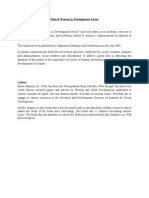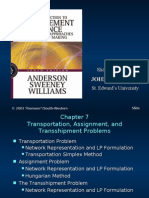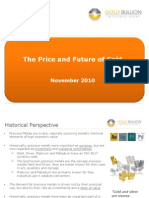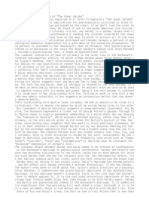0 ratings0% found this document useful (0 votes)
406 viewsSandhya Rani
Sandhya Rani
Uploaded by
Ratnesh SinghThis document analyzes women's education in India. It discusses how women make up 50% of India's population but literacy rates remain low at 54.16% according to the 2001 census. While education programs have expanded, a gender gap in literacy persists. International agreements like the UN Declaration of Human Rights established the right to education, but social and economic factors have prevented many women in India from accessing education opportunities. The document examines literacy rates by state and factors contributing to low female literacy like gender inequality, domestic responsibilities of girls, and high dropout rates.
Copyright:
Attribution Non-Commercial (BY-NC)
Available Formats
Download as PDF, TXT or read online from Scribd
Sandhya Rani
Sandhya Rani
Uploaded by
Ratnesh Singh0 ratings0% found this document useful (0 votes)
406 views19 pagesThis document analyzes women's education in India. It discusses how women make up 50% of India's population but literacy rates remain low at 54.16% according to the 2001 census. While education programs have expanded, a gender gap in literacy persists. International agreements like the UN Declaration of Human Rights established the right to education, but social and economic factors have prevented many women in India from accessing education opportunities. The document examines literacy rates by state and factors contributing to low female literacy like gender inequality, domestic responsibilities of girls, and high dropout rates.
Original Description:
women education
Copyright
© Attribution Non-Commercial (BY-NC)
Available Formats
PDF, TXT or read online from Scribd
Share this document
Did you find this document useful?
Is this content inappropriate?
This document analyzes women's education in India. It discusses how women make up 50% of India's population but literacy rates remain low at 54.16% according to the 2001 census. While education programs have expanded, a gender gap in literacy persists. International agreements like the UN Declaration of Human Rights established the right to education, but social and economic factors have prevented many women in India from accessing education opportunities. The document examines literacy rates by state and factors contributing to low female literacy like gender inequality, domestic responsibilities of girls, and high dropout rates.
Copyright:
Attribution Non-Commercial (BY-NC)
Available Formats
Download as PDF, TXT or read online from Scribd
Download as pdf or txt
0 ratings0% found this document useful (0 votes)
406 views19 pagesSandhya Rani
Sandhya Rani
Uploaded by
Ratnesh SinghThis document analyzes women's education in India. It discusses how women make up 50% of India's population but literacy rates remain low at 54.16% according to the 2001 census. While education programs have expanded, a gender gap in literacy persists. International agreements like the UN Declaration of Human Rights established the right to education, but social and economic factors have prevented many women in India from accessing education opportunities. The document examines literacy rates by state and factors contributing to low female literacy like gender inequality, domestic responsibilities of girls, and high dropout rates.
Copyright:
Attribution Non-Commercial (BY-NC)
Available Formats
Download as PDF, TXT or read online from Scribd
Download as pdf or txt
You are on page 1of 19
ISSN 0975 5942
Vol.II(1), January-June 2010, pp.106-124
Visit: http://www.socialsciences-ejournal.org
Womens Education in India An Analysis
G. Sandhya Rani
Associate Professor, Department of Womens Studies
Sri Padmavati Mahila Visvavidyalayam (Womens University)
Tirupati 517 502, A..P., India
E-mail: sandhya_gudipudi@yahoo.co.in
Abstract
Education is a reasonably good indication of development
and the right of every individual to education is one of the first
provisions of the Universal Declaration on Human Rights. But
education is often neglected in societies struggling to meet the needs
of their people. Recently education has received greater priority as
Planners and Policy makers finally recognized it as a key factor in
determining the pace of development. Women in India constitute 50
per cent of the countrys human resources and their contributions
are vital for the nations progress. But the magnitude of illiteracy
among women is very high. Only 54.16 per cent of women are
literates as per 2001 census. Even though the education system
expanded very rapidly, the gender gap in literacy remains
conspicuous by its presence. The Constitution of India confers on
women, equal rights and opportunities in all fields. The Government
of India has endorsed the same through its Plans, Policies and
Programmes. In spite of all these, women in India have not been
able to take full advantage of their rights and opportunities in
practice for various reasons. Therefore in this paper an attempt has
been made to highlight the International and National initiatives to
promote womens education in India.
Keywords: Women, Education, Gender Sensitization, Low Literacy
factors
G. Sandhya Rani
Asia-Pacific Journal of Social Sciences, Vol.II(1), Jan-June 2010, pp.106-124
107
Introduction
Women in India constitute 50 per cent of the countrys human
resources and their contributions are vital for the nations progress.
Womens development is regarded as an important approach to raise
the levels of productivity and to break the vicious circle of poverty,
for which better health and education forms important. These factors
not only improve the physical well being of the individuals directly,
but also enhance their productivity and ability to contribute to the
National Income.
In any society education is a reasonably good indicator of
development. Spread and diffusion of literacy is generally associated
with essential trait of todays civilization such as modernization,
urbanization, industrialization, communication and commerce.
Therefore to acquire a better quality of life, education is
highly essential. The word education implies the characteristics of
both the types of knowledge, material as well as spiritual. Mahatma
Gandhi said that education is a means for an all round drawing out
of the best in child and man-body, mind and spirit. Literacy is not
the end of the education or even the beginning. It is one of the means
where man and woman can be educated. Thus Gandhijis concept
of education stands for the balanced and harmonious development of
all the aspects of human personality. Moreover, the Human Rights
concept also tells that each human being has right to live with human
dignity (Universal Declaration of Human Rights, 1948, Articles 14-
26).
The Constitution of India also confers on women, equal rights
and opportunities in all fields political, social, economic and legal.
The Government of India, has endorsed the same through its Plans,
Policies and Programmes launched at different points of time. The
article 15 of the Constitution of India prohibits any discrimination on
grounds of sex (Constitution of India Article 15(1)(3)). In spite of
these, women have not been able to take full advantage of their rights
and opportunities in practice for various reasons.
The magnitude of illiteracy among women in India is very
high. Only 54.16 per cent of women are literates as per 2001 census.
It reflects that India is not utilizing the potential workers in a proper
way. There is either unutilisation or under utilization of womens
G. Sandhya Rani
Asia-Pacific Journal of Social Sciences, Vol.II(1), Jan-June 2010, pp.106-124
108
capacities and skills. Therefore in this paper an attempt has been
made to highlight the International as well as National responses
towards womens education. At the end of the article some measures
are suggested to overcome the problem of illiteracy among women
and to foster their journey towards a dignified and decent life.
Methodology
The data for the present study have been gleaned from various
sources which have been duly acknowledged. Information on
womens enrolment at different levels of University and professional
colleges was obtained through the reports of the University Grants
Commission, New Delhi and The Report on Selected Educational
Statistics, Published by the Statistics Division, Ministry of Human
Resource Development, New Delhi 2007.
Observation and Data Analysis
Womens Right to Education: It is nearly six decades since the UN
General Assembly adopted the Declaration of Human Rights on
10
th
December 1948. This declaration listed 30 Articles. Out of
which:
The Article 26 states that:
Every one has the right to education. Education shall be free,
at least in the elementary and fundamental stages.
Elementary education shall be compulsory. Technical and
professional education shall be made generally available and
higher education shall be equally accessible to all on the basis
of merit.
Education shall be directed to the full development of the
human personality and to the strengthening of respect for
human rights and fundamental freedoms. It shall promote
understanding, tolerance and friendship among all nations,
racial, religious groups and shall further the activities of the
United Nations for the maintenance of peace.
Parents have a prior right to choose the kind of education that
shall be given to their children.
The reality exposed: In Independent India, education acquired
special significance and has been supported by the Government from
time to time through its policies and programmes. Therefore in recent
years the education system expanded rapidly. But the gender gap in
literacy rate remains conspicuous by its presence. The following
G. Sandhya Rani
Asia-Pacific Journal of Social Sciences, Vol.II(1), Jan-June 2010, pp.106-124
109
facts and figures throw light on the gravity of the problem which is a
reality and the seriousness of the task ahead.
Table I reveals the percentages of literacy rates as per 2001
census among males and females in India. The gap which was 18.30
per cent in 1951 increased to 25.05 per cent in 1961 and 26.62 per
cent in 1981 (Table-1). After that there was a slow decrease in the
gap as the literary rate among women started gradually increasing
after 1991 (54.16% in 2001) due to the interventions taken by the
government (Census of India, 2001). But still nearly 46 per cent of
women are illiterates. The same is shown in Figure 1.
Table-2, clearly shows the percentage of female literacy rates
in India as per 2001 census. Kerala state is highest with 87.86 per
cent and among Union Territories, Lakshadweep occupies first place
with 81.56 per cent. In Uttar Pradesh only 42.98 per cent women are
literate followed Arunachal Pradesh with 44.24 per cent. Among the
six Union Territories except in Dadra and Nagar Haveli (42.99 per
cent) in all the other UTs the female literacy rate is more than 70 per
cent (Primary Census Abstract, 2001).
The participation of girls at all stages of education has been
increasing steadily through the years as may be seen from Table-3.
Since 1950-51 girls participation has increased many folds in
Primary, Middle, Sec./Sr.Sec. stages and Hr. Education levels from
28.1% to 46.7%, from 16.1% to 44.4% from 13.3% to 41.5% and
from 10.0% to 38.9% respectively. However, the girls participation
is still below fifty per cent at all stages of education (Fig.2).
(Selected Educational Statistics, MHRD, India, 2007).
Factors Responsible for Low Literacy Rates among Women:
The literacy rate in the country has increased from 18.33 per cent in
1951 to 65.38 per cent in 2001 census. The female literacy rate has
also increased from 8.86% to (in 1951) to 54.16% (in 2001). It is
noticed that female literacy during the period 1991-2001 has
increased by 14.87% where as male literacy has rose by 11.72%.
Though there is an increase in female literacy rate, still 46% of
women are illiterates in India (Statistics on Women, 2007).
In spite of a number of National and International
Programmes are in implementation to eradicate illiteracy from our
G. Sandhya Rani
Asia-Pacific Journal of Social Sciences, Vol.II(1), Jan-June 2010, pp.106-124
110
country, especially among women, the gap between male and female
literacy still persists. In this context, the factors responsible for low
female literacy rate in India are identified and listed below:
Gender based inequality.
Social discrimination and economic exploitation
Occupation of girl child in domestic chores
Low enrolment of girls in schools
Low retention rate and high dropout rate.
Deprived of access to information and alienated from
decision making processes.
Absence of female teachers in schools.
Schools established in far away places etc.
As a result of these factors, women are caught in a vicious
self perpetuating cycle and their inability to pursue education again
reinforces the stereotype of jobs, among women.
Womens Education-The International and National Initiatives
International Initiatives:India has ratified various International
Conventions and Human Rights instruments committing to secure
equal rights of women. Key among them is the ratification of the
Convention on Elimination of All Forms of Discrimination Against
Women (CEDAW, 1979) in 1993. CEDAW was adopted by United
Nations General Assembly (UNGA) in December 1979, and there are
more than 150 states parties to the convention.
CEDAW 1979: This Convention calls for equal rights for women
regardless their married status in all fields - political, economic,
social, cultural and civil. It appeals for a national legislature to ban
discrimination; recommends temporary special measures to spread
equality between men and women and actions to modify social and
cultural pattern that perpetuates discrimination (CEDAW 1979).
UNICEF, Report in 1992 Conference on Education for All Girls:
Programmes of Womens Studies have attempted to dismantle
stereotypes and build up womens esteem. Special studies reveal
both the extent to which women have been deprived and oppressed
and elements in the tradition of all civilization that promote positive
G. Sandhya Rani
Asia-Pacific Journal of Social Sciences, Vol.II(1), Jan-June 2010, pp.106-124
111
images to and ease the conflicts experienced by many women in
pursuit of their advancement and new roles in society.
The UACs programme for promoting Womens Studies
envisages assistance to Universities for setting up centers and cells
for Womens Studies. The centers and cells are required to undertake
research, develop curricula and organize training and extension work
in the areas of gender equality, economic, self reliance of women,
girls education, population issues, issues of human rights and social
exploration (Vina Mazumdar, 2003).
Beijing Conference: Platform for Action 1995: The Mexico Plan
of Action (1975), the Nairobi Forward Looking Strategies (1985), the
Beijing Declaration as well as the Platform of Action (1995) and the
outcome Document adopted by the UNGA (United Nations General
Assembly) Session on Gender Equality and Development and Peace
for the 21
st
century, titled Further actions and initiatives to
implement the Beijing Declaration and the Platform of action have
been unreservedly endorsed by India for appropriate follow up.
Beijing Conference adopted a Declaration and Platform of
Action on the concluding day. The Platform of Action is addressing
the unequal access to and inadequate educational opportunities to
women suggested the following strategies to be adopted by the
Governments.
Strategic objective 1: Ensure equal access to education
Strategic objective 2: Eradicate illiteracy among women
Strategic objective 3: Improve womens access to vocational
training, science and technology and continuing education.
Strategic objective 4: Develop non-discriminate education and
training
Strategic objective 5: Promote lifelong education and training for
girls and women (Beiging Platform of Action Five Years After
2002).
Education for All: The World Conference on Education for All,
sponsored by UNESCO, UNICEF, the World Bank and the UNDP,
held in 1990 took stock of the persistence and dimensions of the
gender gap. Its final Declaration stated that drawing attention to poor
environments experienced by hundreds of millions of girls, it calls
G. Sandhya Rani
Asia-Pacific Journal of Social Sciences, Vol.II(1), Jan-June 2010, pp.106-124
112
for ensuing that all learners receive the nutrition, health care and
general physical and emotional support they need.
National Response: The development strategy in Independent India
in the 1950s depended heavily on planning. Therefore the
development plans prepared for Five years are referred as the Five
Year Plans. The first two plans referred to the problems of womens
education and occupation. The Report of the Committee on the
Education of Women 1959, made extensive recommendations
which led to a more focused thrust in the subsequent plans. But
disparities in the literacy rates between men and women continued.
These were amply substantiated by the Report of Committee on the
Status of Women, 1974. This led to a broader perspective and the
Sixth Plan linked education to the participation of women in the
development process (Status of Women, 1974).
The National Policy on Education (NPE) 1986 revised in
1992 took an even broader view in underscoring the role of education
in empowering women in order to overcome inequalities and
disparities.
It has been regarded as a land mark in the approach to womens
education and also attempted for the first time to address itself to the
basic issues of womens equality.
Education will be used as an agent of basic change in the
status of women. In order to neutralize the accumulated distortion of
the past, there will be a well conceived edge in favour of women.
The National education system will play a positive, interventionist
role in the empowerment of women. It will foster the development
of new values, through redesigned curricula, text books, training and
orientation of teachers, decision makes and administrators.
The NPE also provided detailed information about the
recommendations of the Rammurthy Committee and Education for
All by 2000 AD. This has presented an over view on the status of
womens education in India since 1995 in all its aspects, particularly
empowering women through Mahila Samakya Programmes. These
programmes are directed to create a learning environment where
women can collectively affirm their aim, the strength to demand
G. Sandhya Rani
Asia-Pacific Journal of Social Sciences, Vol.II(1), Jan-June 2010, pp.106-124
113
information and knowledge and move forward towards attaining a
quality life (New Education Policy, 1986, 1992).
The Eighth Five Year Plan marked the adoption of two
National Plans for Action in 1992. One for children and the other
one exclusively for the girl child (VIII Five Year Plan, 1992-97).
In the Ninth Plan the thrust was on strengthening the early
joyful period of play and learning in the young childs life to ensure a
harmonious transition from the family environment to the primary
school. Towards this, special efforts were made to develop linkages
between ICDS (Integrated Child Development Scheme) and primary
education. Their operational linkage aimed at reinforcing
coordination of timings and location based on community appraisal
and micro planning at grass root level. Girls education was viewed
as a major intervention for breaking the vicious inter-generational
cycle of gender and socio-economic disadvantages. The effective
expansion of day care services, linkages of child care services and
primary schools was a major input to promote developmental
opportunities for the girl child for participation in primary education
and supportive services for women (IX Five Year Plan, 1997-2002).
During X Five Year Plan a programme called Sarva Siksha
Abiyan was launched with an objective that all the children in the
school going age (below 14 years) in India , must be in schools and
should complete five years of schooling by 2007 (X Five Year Plan,
2002-07).
Dr. Manmohan Singh, Prime Minister of India has termed the
XI Five Year Plan as Indias Educational Plan. The NDC (National
Development Council) in December 2007, places the highest priority
on education as a central instrument for achieving rapid and inclusive
growth. It aims at:
1. Increase literary rate for persons of age 7 years or more to
85%.
2. Lowering gender gap in literacy to 10 percentage points.
3. Reduction of dropout rate of children from elementary school
from 52.2% to 20% by 2011-12.
4. Developing minimum standards of education attainment in
elementary school, and by regular testing, monitoring the
G. Sandhya Rani
Asia-Pacific Journal of Social Sciences, Vol.II(1), Jan-June 2010, pp.106-124
114
effectiveness of education to ensure quality (XI Five Year
Plan, 2007-12).
Education for All (EPA) - Indian Context: Education for all,
means extending educational opportunities to all, regardless of race,
colour, creed, sex or ability. In the Indian context, EPA implies the
following:
Universalisation of Elementary Education UEE.
Expansion of Early Childhood Care and Education ECCE.
Equalization of Educational opportunities for women.
Removal of regional and gender disparities
A systematic programme for Non-Formal Education
Imparting basic education
Providing vocational training etc.
Gender Sensitization: Government attaches greater importance to
those efforts which trigger changes in social attitudes towards
women. The womens development division of the National Institute
of Public Cooperation and Child Development, New Delhi ,organizes
training programmes with a focus on gender issues. These
programmes include para-legal training, training of elected women
representatives of panchayats, leadership and organization, training
of voluntary agencies reaching women awareness and gender
sensitization programmes, incorporation of gender issues in
development programmes etc.
In addition to this the Womens Studies Centers established
in various Institutions and Universities have been imparting training
on Gender Sensitization to different target groups (students, officials,
administrators, police personnel, Panchayat Raj functionaries etc.)
The programme of education for prevention of atrocities
against women was started in 1982. Based upon the
recommendations made in the National Perspective Plan (1988), and
the National Policy for the Empowerment of Women (2001) the
proposal for setting up National Resource Centers for women is
now at an advanced stage.
Expenditure by level of Education in India: Table-4, reveals that
the total expenditure on all sectors (Elementary, Secondary/Higher
G. Sandhya Rani
Asia-Pacific Journal of Social Sciences, Vol.II(1), Jan-June 2010, pp.106-124
115
Secondary, Adult and University level education has been increased
from Rs. 1,46,711.53 to 8,19,231.90 lakh crores during the period
from 1990-91 to 2004-05. The Govt. of India has been investing
mainly on Primary Education followed by Secondary, Adult and
Higher Education. The percentage of education in total expenditure
on all sectors is also gradually increasing except during the years
2001-02 to 2004-05. Figure 3 gives a clear picture of the expenditure
invested in education sector.
Strategies adopted by the Government for increasing female
literacy in the country
The main strategies adopted by the Government for
increasing female literacy in the country include (National Literacy
Mission, 1988):
1. National Literacy Mission for imparting Functional
Literacy.
2. Universalisation of Elementary Education.
3. Non-Formal Education.
Contribution of Literacy Campaigns to Female Literacy: The
provision of educational opportunities for women has been an
important part of the national endeavour in the field of education
since Indias Independence. Though these endeavours did yield
significant results, gender disparity persists with uncompromising
tenacity, more so in the rural areas and among the disadvantaged
communities. This is not only a matter of national anxiety and
concern but also a matter of national conscience. It is with this
concern that the Government of India launched the National Literacy
Mission in 1988 for eradication of adult literacy. Since women
account for an overwhelming percentage of illiterates, the National
Literacy Mission - Mission of imparting functional literacy to women
was launched in 1988. The total Literacy Campaigns launched since
1988 under the aegis of the National emphasis are making efforts to:
Create an environment where women demand knowledge and
information, empowering themselves to change their lives.
Inculcate in women the confidence that change is possible, if
women work collectively.
Spread the message that education of women is a pre-
condition for fighting against their oppression.
G. Sandhya Rani
Asia-Pacific Journal of Social Sciences, Vol.II(1), Jan-June 2010, pp.106-124
116
Highlight the plight of the girl child and stress the need for
Universaliation of Elementary Education as a way of
addressing the issue.
Some of the significant ways in which the literacy campaigns
have contributed to the promotion of female literacy and womens
empowerment are as follows:
Heightened social awareness among women
Increased school enrolment rate of girls.
Increased self-confidence and personality development
Promoted gender equity and womens empowerment
Improved the status of women in the family
Educational equity Gender gap in literacy levels have
gradually reduced
Encouraged Women to take up entrepreneurship.
Increased household savings and access to credit
Provided awareness about health and hygiene
In addition to the above, the following are the some strategies
recommended to encourage girls/womens education in India.
Involving womens groups like DWCRA and Self Help
Groups in promoting womens literacy
Providing free and compulsory education for all girls up to 20
years.
Establishment of more number of primary school.
Bringing out changes in the attitudes of parents and in the
society.
Inclusion of Literacy programmes in all governmental
schemes.
Effective implementation of follow up programme.
Removal of gender bias in the school curriculum
Establishment of more number of NFE (Non-Formal
Education) schools to enroll girls and women of different age
groups.
Widening the scope of Distance Education Programme to
cover all categories of people especially rural women.
Conclusion
The right of every individual to education is one of the first
provisions of the Universal Declaration on Human Rights. But
G. Sandhya Rani
Asia-Pacific Journal of Social Sciences, Vol.II(1), Jan-June 2010, pp.106-124
117
education is often neglected in societies struggling to meet the many
needs of their people. Recently education has received greater
priority as Planners and Policy makers finally recognized it as a key
factor in determining the pace of development.
Creating educational opportunities for girls and women is
strongly emphasized in the work of the UN. CEDEW suggests
encouraging co-education as one way of eliminating the
stereotyping of women. Education, being the most powerful
instrument for empowering women assumes special priority in the
recent plans and programmes of National and International action.
Concerted efforts are also made to bring more women into the
purview of education. In spite of these many provisions, still there is
a wide gap between male and female literacy levels in India.
Keeping this in view the programme of action for future has to be
formulated so as to reduce the gender gap as well as illiteracy rate
among girls and women.
G. Sandhya Rani
Asia-Pacific Journal of Social Sciences, Vol.II(1), Jan-June 2010, pp.106-124
118
References
Beijing Platform for Action, Five Years After, Department of Women
and Child Development, Ministry of Human Resource
Development, Govt. of India, June, 2000.
Census of India - 2001, Govt. of India, Part III, NSS 61
st
Round
Survey Report, 2004-05, p.24.
Constitution of India, Article 15(1)(13).
Five Year Plans, Govt. of India, Planning Commission (1992-2012).
Govt. of India, Selected Educational Statistics, 2004-05, Ministry of
Human Resources Development, Department of Higher
Education, Statistics Division, pp. 146-147, 2007.
Mazumdar, Vina, Evolution of Womens Studies in India. Dialouge
with Researchers: Linking Policy and Research A
Consultation on Womens Studies, New Delhi: Centre for
Womens Development Studies, pp 47-49, 2002.
National Perspective Plan, Department of Women and Child
Development, Government of India, pp. 67-80.
National Policy for the Empowerment of women, Department of
Women and Child Development, Ministry of Human
Resource Development, Government of India, 2001.
National Policy on Education, POA Ministry of Education,
Government of India, 1986.
Recommendations of the Committee on the Status of Women in
India, and Views of the Empowered Committee (Inter-
Ministerial), Govt. of India, Ministry of Education and Social
Welfare, 1974.
Statistics on Women, National Institute of Public Cooperation and
Child Development, New Delhi, 2007.
Universal Declaration of Human Rights, 1948.
Websites consulted
www.nlm.nic.in
www.planindia.org/images/education
http://www.unifem.undp.org/cedaw/indexes.htm
G. Sandhya Rani
Asia-Pacific Journal of Social Sciences, Vol.II(1), Jan-June 2010, pp.106-124
119
Table 1: Literacy rates in India 1951-2001 (%)
Year Persons Males Females
Male Female gap in
Literacy rate
1951 18.33 27.16 8.86 18.30
1961 28.30 40.40 15.35 25.05
1971 34.45 45.96 21.97 23.98
1981 43.57 56.38 29.76 26.62
1991 52.21 64.13 39.29 24.84
2001 65.38 75.85 54.16 21.70
2004-05 67.30 77.00 57.00 20.00
Source: Census India, Part III, 2001, NSS 61
st
Round Survey Report No.
517, 2004-05, p.24.
G. Sandhya Rani
Asia-Pacific Journal of Social Sciences, Vol.II(1), Jan-June 2010, pp.106-124
120
Table 2: State-wise and gender wise literacy rates in
rural/urban areas Census 2001
Sl.
No
Name of the State
Rural Urban Total
P
e
r
s
o
n
M
a
l
e
F
e
m
a
l
e
P
e
r
s
o
n
M
a
l
e
F
e
m
a
l
e
P
e
r
s
o
n
M
a
l
e
F
e
m
a
l
e
1 Andhra Pradesh 54.50 65.35 43.50 76.09 83.19 68.74 60.47 70.32 50.43
2 Arunachal Pradesh 47.83 57.65 36.94 78.26 85.19 69.49 54.34 63.83 43.53
3 Assam 59.73 68.22 50.70 85.34 89.74 80.24 63.25 71.28 54.61
4 Bihar 43.92 57.09 29.61 71.93 79.94 62.59 47.00 59.68 33.12
5 Chattisgarh 60.48 74.09 46.99 80.58 89.39 71.11 64.66 77.38 51.85
6 Goa 79.67 87.37 71.92 84.39 89.46 78.98 82.01 88.42 75.37
7 Gujarat 61.29 74.11 47.84 81.84 88.34 74.50 69.14 79.66 57.80
8 Haryana 63.19 75.37 49.27 79.16 85.83 71.34 67.91 78.49 55.73
9 Himachal Pradesh 75.08 84.51 65.68 88.95 92.04 85.03 76.48 85.35 67.42
10 Jammu & Kashmir 49.78 61.65 36.74 71.92 80.00 61.98 55.52 66.60 43.00
11 Jharkhand 45.74 60.94 29.89 79.14 87.03 69.96 53.56 67.30 38.87
12 Karnataka 59.33 70.45 48.01 80.58 86.66 74.12 66.64 76.10 56.87
13 Kerala 90.04 93.63 86.69 93.19 95.94 90.62 90.86 94.24 87.72
14 Madhya Pradesh 57.80 71.70 42.76 79.39 87.39 70.47 63.74 76.06 50.29
15 Maharashtra 70.36 81.93 58.40 85.48 91.03 79.09 76.88 85.97 67.03
16 Manipur 67.29 77.31 56.95 79.26 88.71 70.01 70.53 80.33 60.53
17 Meghalaya 56.29 59.24 53.24 86.30 89.05 83.50 62.56 65.43 50.61
18 Mizoram 81.27 84.93 77.26 96.13 96.43 95.80 88.80 90.72 86.75
19 Nagaland 62.79 67.58 57.52 84.74 87.44 81.42 66.59 71.16 61.46
20 Orissa 59.84 72.93 46.66 80.84 87.93 72.87 63.08 75.35 50.51
21 Punjab 64.72 71.05 57.72 79.10 83.05 74.49 69.65 75.23 63.36
22 Rajasthan 55.4 72.16 37.33 76.20 86.45 64.67 60.41 75.70 43.85
23 Sikkim 66.82 74.45 58.01 83.91 87.81 79.16 68.81 76.04 60.40
24 Tamil Nadu 66.21 77.15 55.28 82.53 88.97 75.99 73.45 82.42 64.43
25 Tripura 69.72 78.40 60.50 89.21 93.21 85.03 73.19 81.02 64.91
26 Uttaranchal 52.53 66.59 36.90 69.75 76.76 61.73 56.27 68.82 42.22
27 Uttar Pradesh 68.07 81.78 54.70 81.44 87.05 74.77 71.62 83.28 59.63
28 West Bengal 63.42 73.13 53.16 81.25 86.13 75.74 68.64 77.02 59.61
29 Andaman &
Nicobar Islands
78.70 84.14 72.26 86.57 90.65 81.47 81.30 86.33 75.24
30 Chandigarh 75.58 80.96 66.37 82.64 86.78 77.40 81.94 86.14 76.47
31 Dadra & Nagar
Haveli
49.34 64.50 30.83 84.36 90.84 74.54 57.63 71.18 40.23
32 Daman & Diu 75.83 84.83 59.33 82.31 91.12 73.41 78.18 86.76 65.61
33 Delhi 78.05 86.60 67.39 81.93 87.39 75.22 81.67 87.33 74.71
34 Lakshadweep 85.04 91.49 78.27 88.62 93.77 83.13 86.66 92.53 80.47
35 Pondicherry 73.98 83.50 64.38 84.84 91.18 78.57 81.24 88.62 73.90
INDIA 58.74 70.70 46.13 79.92 86.27 72.86 64.84 75.26 53.67
Source: Primary Census Abstract: Census of India 2001.
G. Sandhya Rani
Asia-Pacific Journal of Social Sciences, Vol.II(1), Jan-June 2010, pp.106-124
121
Table 3: Percentage of Girls enrolment to total enrolment by
stages, 1950-51 to 2004-05
Year
Primary
I-V
Upper
Primary
VI-VIII
Sec./Sr.
Sec/
Intermediate
(IX-XII)
Hr.
Education
(Degree &
above level)
1950-51 28.1 16.1 13.3 10.0
1955-56 30.5 20.8 15.4 14.6
1960-61 32.6 23.9 20.5 16.0
1965-66 36.2 26.7 22.0 20.4
1970-71 37.4 29.3 25.0 20.0
1975-76 38.1 31.3 26.9 23.2
1980-81 38.6 32.9 29.6 26.7
1985-86 40.3 35.6 30.3 33.0
1990-91 41.5 36.7 32.9 33.3
1991-92 41.9 38.2 33.8 32.3
1992-93 42.6 38.8 33.9 33.2
1993-94 42.7 39.1 34.3 33.5
1994-95 42.9 39.3 35.9 34.0
1995-96 43.1 39.5 36.1 36.0
1996-97 43.2 39.9 36.4 36.7
1997-98 43.5 40.3 36.5 37.5
1998-99 43.9 30.8 37.8 38.8
1999-00 43.6 40.4 38.9 38.7
2000-01* 43.7 40.9 38.6 39.4
2001-02* 44.1 41.8 39.5 39.9
2002-03* 46.8 43.9 41.3 40.1
2003-04* 46.7 44.0 41.1 39.7
2004-05* 46.7 44.4 41.5 38.9
*Provisional
Source: Govt. of India, Selected Educational Statistics, 2004-05, Ministry
of Human Resources Development, Department of Higher
Education, Statistics Division, pp. 146-147, 2007.
G. Sandhya Rani
Asia-Pacific Journal of Social Sciences, Vol.II(1), Jan-June 2010, pp.106-124
122
Table 4: Expenditure by level of Education in India ( in crores)
Year
Total expenditure on education and training (Rev) by Education and other Departments
T
o
t
a
l
e
x
p
.
O
n
a
l
l
s
e
c
t
o
r
s
(
R
e
v
)
G
D
P
a
t
c
u
r
r
e
n
t
p
r
i
c
e
s
(
a
t
f
a
c
t
o
r
c
o
s
t
b
a
s
e
y
e
a
r
1
9
9
3
-
9
4
Elementary
Secondary/Higher
Secondary
Adult Education
University & Higher
Edn.*
Total
E
x
p
e
n
-
d
i
t
u
r
e
%
a
g
e
t
o
G
D
P
%
a
g
e
t
o
t
o
t
a
l
e
x
p
.
O
n
a
l
l
s
e
c
t
o
r
E
x
p
e
n
-
d
i
t
u
r
e
%
a
g
e
t
o
G
D
P
%
a
g
e
t
o
t
o
t
a
l
e
x
p
.
O
n
a
l
l
s
e
c
t
o
r
E
x
p
e
n
-
d
i
t
u
r
e
%
a
g
e
t
o
G
D
P
%
a
g
e
t
o
t
o
t
a
l
e
x
p
.
O
n
a
l
l
s
e
c
t
o
r
E
x
p
e
n
-
d
i
t
u
r
e
%
a
g
e
t
o
G
D
P
%
a
g
e
t
o
t
o
t
a
l
e
x
p
.
O
n
a
l
l
s
e
c
t
o
r
E
x
p
e
n
-
d
i
t
u
r
e
%
a
g
e
t
o
G
D
P
%
a
g
e
t
o
t
o
t
a
l
e
x
p
.
O
n
a
l
l
s
e
c
t
o
r
1990-91 9076 1.78 6.19 6310 1.24 4.30 273 0.05 0.19 3956 0.77 2.70 19616 3.84 13.37 146712 510954
1991-92 10368 1.76 6.09 7401 1.26 4.34 229 0.04 0.13 4397 0.75 2.58 22394 3.80 13.14 170370 589086
1992-93 11322 1.68 5.95 8575 1.27 4.51 211 0.03 0.11 4923 0.73 2.59 25030 3.72 13.15 190327 673221
1993.94 13071 1.67 5.96 9371 1.20 4.29 280 0.04 0.13 5557 0.71 2.54 28280 3.62 12.94 218535 781345
1994-95 15133 1.65 6.01 10836 1.18 4.30 338 0.04 0.13 6300 0.69 2.50 32606 3.56 12.95 251692 927058
1995-96 18434 1.72 6.44 1253 1.17 4.38 260 0.02 0.09 6954 0.65 2.43 38178 3.56 13.34 286195 1073271
1996-97 21544 1.73 6.54 14164 1.14 4.30 206 0.02 0.06 7983 0.64 2.42 43896 3.53 13.33 329390 1243547
1997-98 24083 1.73 6.49 1566 1.13 4.22 210 0.02 0.06 8596 0.62 2.32 48552 3.49 13.09 370838 1390148
1998-99 30191 1.9 6.87 20101 1.26 4.57 189 0.01 0.04 11097 0.69 2.52 61579 3.85 14.00 439768 1598127
1999-00 34069 1.93 6.65 25448 1.44 4.97 187 0.01 0.04 15113 0.86 2.95 74816 4.25 14.60 512519 1761838
2000-01 39275 2.06 6.86 26058 1.37 4.55 226 0.01 0.04 16928 0.89 2.96 82486 4.33 14.42 572160 1902998
2001-02 40019 1.91 6.46 25163 1.20 4.06 360 0.02 0.06 14323 0.69 2.31 79866 3.82 12.89 619713 2090957
2002-03 41747 1.86 6.15 27499 1.22 4.05 402 0.02 0.06 15859 0.70 2.34 85507 3.80 12.60 678548 2249493
2003-04 44349 1.74 5.96 28476 1.12 3.83 396 0.02 0.05 15858 0.62 2.13 89079 3.50 11.98 743669 2543396
2004-05
(RE)
53797 1.89 6.57 31506 1.11 3.85 450 0.02 0.05 18813 0.66 2.30 104566 3.68 12.76 819232 2843897
*Including expenditure on Physical education, Technical education, Language development etc.
Note: Expenditure on education by other Departments has been distributed be level, on the basis of expenditure (%) by education departments.
RE : Revised Estimates.
Source: Govt. of India, Selected Educational Statistics, 2004-05, Ministry of Human Resources Development, Department of Higher Education, Statistics
Division, pp. 146-147, 2007.
G. Sandhya Rani
Asia-Pacific Journal of Social Sciences, Vol.II(1), Jan-June 2010, pp.106-124
123
0
10
20
30
40
50
60
70
80
P
e
r
c
e
n
t
a
g
e
1951 1961 1971 1981 1991 2001 2004-05
Year
Figure 1: Literacy rates in India
Persons Males Females Male female gap in literacy rate
Figure 2: Percentage of Girls Enrolment to Total Enrolment
0
5
10
15
20
25
30
35
40
45
50
1950-51 1960-61 1970-71 1980-81 1990-91 2000-01 2004-05
Year
P
e
r
c
e
n
t
a
g
e
Primary Upper Primary Sec./Sr.Sec Hr.Edn.
G. Sandhya Rani
Asia-Pacific Journal of Social Sciences, Vol.II(1), Jan-June 2010, pp.106-124
124
Figure 3: Expenditure by level of Education in India
0
500000
1000000
1500000
2000000
2500000
3000000
1990-91 1991-92 1992-93 1993.94 1994-95 1995-96 1996-97 1997-98 1998-99 1999-00 2000-01 2001-02 2002-03 2003-04 2004-05
(RE)
Year
Total exp. On all sectors (Rev) GDP at current prices (at factor cost) base year 1993-94
You might also like
- He Koronga Matua Na Puhaanga - Ngati Mahanga The Lands of Hamilton WestDocument27 pagesHe Koronga Matua Na Puhaanga - Ngati Mahanga The Lands of Hamilton Westapi-35202315390% (10)
- Sales Plan Template 2 PDFDocument12 pagesSales Plan Template 2 PDFRatnesh SinghNo ratings yet
- Safe Container Convention - OCT 2014Document52 pagesSafe Container Convention - OCT 2014S M Hasan100% (1)
- Womens Education in India A Situational AnalysisDocument15 pagesWomens Education in India A Situational AnalysisyashbhardwajNo ratings yet
- Women - Health - and - Sustainable Development - 1Document22 pagesWomen - Health - and - Sustainable Development - 1Suman PathakNo ratings yet
- Journal On Girl Education in IndiaDocument4 pagesJournal On Girl Education in IndiaBrian MosesNo ratings yet
- Women Empowernment and EducationDocument95 pagesWomen Empowernment and EducationSandhya TripathiNo ratings yet
- Gender Gaps and Women's Empowerment in India - Issues and StrategiesDocument9 pagesGender Gaps and Women's Empowerment in India - Issues and StrategiesDeepesh KumarNo ratings yet
- Women Education As An Effective Instrument For Family AdvancementDocument58 pagesWomen Education As An Effective Instrument For Family AdvancementmohammadsadiqkanamNo ratings yet
- Women Empowerment: Source To Economical DevelopmentDocument3 pagesWomen Empowerment: Source To Economical Developmentinventionjournals100% (1)
- Open Distance Learning Promoting Gender Lacuna: A PerspectiveDocument13 pagesOpen Distance Learning Promoting Gender Lacuna: A PerspectiveAnonymous CwJeBCAXpNo ratings yet
- Literary ProgressDocument18 pagesLiterary Progressads112822No ratings yet
- Women Empowerment Through Education: Dr. Vibha GuptaDocument8 pagesWomen Empowerment Through Education: Dr. Vibha GuptaShyamsunder SinghNo ratings yet
- Female Literacy in Bihar: Plans, Policies and Its Social ImpactDocument7 pagesFemale Literacy in Bihar: Plans, Policies and Its Social ImpactSrijesh SinghNo ratings yet
- Aggarwal Et Al 2021 Building Literacy Skills of Urban Poor Women Through The Each One Enable One ApproachDocument19 pagesAggarwal Et Al 2021 Building Literacy Skills of Urban Poor Women Through The Each One Enable One ApproachPradeep HegdeNo ratings yet
- Empowering Women, Developing Society-2211Document7 pagesEmpowering Women, Developing Society-2211jha265627No ratings yet
- Economics ProjectDocument18 pagesEconomics Projectamritach477No ratings yet
- Politics of Women's Education, Amna SandhuDocument24 pagesPolitics of Women's Education, Amna SandhuFaisi GikianNo ratings yet
- Soc Education DropoutsDocument8 pagesSoc Education DropoutsNaveen KumarNo ratings yet
- Full Paper KhoirulDocument11 pagesFull Paper KhoirulKhoirul AtmonoNo ratings yet
- Gender Equity in EducationDocument9 pagesGender Equity in EducationShowkeen Bilal Ahmad GulNo ratings yet
- Gender Disparity in Education and Policies of Inclusion: A Sociological Study of Zone H.C Gam of District Kulgam (J&K)Document10 pagesGender Disparity in Education and Policies of Inclusion: A Sociological Study of Zone H.C Gam of District Kulgam (J&K)Shahbaz AhmadNo ratings yet
- A Study On Issues and Challenges of Women Empowerment in IndiaDocument7 pagesA Study On Issues and Challenges of Women Empowerment in IndiaIOSRjournalNo ratings yet
- Problems, Issues & Development of Women EducationDocument6 pagesProblems, Issues & Development of Women EducationAnonymous CwJeBCAXpNo ratings yet
- DraftRajasthan State Women PolicyDocument29 pagesDraftRajasthan State Women PolicyAADYA SHARMANo ratings yet
- 7 Saleha Parveen Article BERDocument9 pages7 Saleha Parveen Article BERAishaKhanNo ratings yet
- Empowering Rural Meo-Muslim Women in Mewat-FinalDocument13 pagesEmpowering Rural Meo-Muslim Women in Mewat-FinalArti ManchandaNo ratings yet
- Khushboo SinghDocument10 pagesKhushboo Singhshalviktiwari11No ratings yet
- Empowerment of Women in India: A Reality or A Myth: Mrs. Nisha DeviDocument8 pagesEmpowerment of Women in India: A Reality or A Myth: Mrs. Nisha Devibindass boyNo ratings yet
- How Higher Education in Rural India Helps Human Rights and EntrepreneurshipDocument6 pagesHow Higher Education in Rural India Helps Human Rights and EntrepreneurshipSukhman SandhuNo ratings yet
- Educational Inequality in Haryana: A Study of Gender Differences in LearningDocument11 pagesEducational Inequality in Haryana: A Study of Gender Differences in LearningUjjwal TripathiNo ratings yet
- Status of Womens Education IndianDocument9 pagesStatus of Womens Education Indianbarbiehans14No ratings yet
- Educational Status of Muslim Women in India: An Overview: FirdausbanoDocument4 pagesEducational Status of Muslim Women in India: An Overview: Firdausbanoamit saikiaNo ratings yet
- Collection of Essay For SSC CGLDocument230 pagesCollection of Essay For SSC CGLswapnamNo ratings yet
- Problems of Female TeacherDocument30 pagesProblems of Female TeacherAnam SaleemNo ratings yet
- Jammu DLL FinalDocument12 pagesJammu DLL FinalGeetika SinghNo ratings yet
- Women EducationDocument18 pagesWomen EducationmukulNo ratings yet
- ch-1 To RefrencesDocument128 pagesch-1 To RefrencesGul BadshahNo ratings yet
- Impact of Higher Education On Women Empowerment in Urban BangladeshDocument18 pagesImpact of Higher Education On Women Empowerment in Urban BangladeshQuazi Moshrur-Ul-AlamNo ratings yet
- Wom EmpDocument1 pageWom EmpRohitNemaNo ratings yet
- Jurnal Empowerment 1Document10 pagesJurnal Empowerment 1Rika MayardiNo ratings yet
- 68IJELS 108202048 Provincial PDFDocument7 pages68IJELS 108202048 Provincial PDFIJELS Research JournalNo ratings yet
- Important Paper PDFDocument14 pagesImportant Paper PDFSakshi OjhaNo ratings yet
- IGNOU Gender Issues of DevelopmentDocument15 pagesIGNOU Gender Issues of DevelopmentAtul Anand100% (1)
- Status of Indian Women in Higher EducationDocument7 pagesStatus of Indian Women in Higher EducationSai AravindNo ratings yet
- Right To Education in India Challenges A PDFDocument12 pagesRight To Education in India Challenges A PDFSanya RastogiNo ratings yet
- DR Anis Jahan - Present Status of Muslims...Document13 pagesDR Anis Jahan - Present Status of Muslims...Intakhab KhanNo ratings yet
- Social Science Project Gender GapDocument10 pagesSocial Science Project Gender GapUtsav Kumar MathurNo ratings yet
- Gender Equality and Women Empowerment in IndiaDocument22 pagesGender Equality and Women Empowerment in IndiaAditi SamdarshiniNo ratings yet
- Educational ProblemsDocument8 pagesEducational ProblemsSaad RehanNo ratings yet
- Role of Women in Development SectorDocument9 pagesRole of Women in Development SectorAnshul VermaNo ratings yet
- FC ProjectDocument5 pagesFC ProjectVishal daradeNo ratings yet
- Gender Equality in Higher Education in India Kalyana BondreDocument17 pagesGender Equality in Higher Education in India Kalyana Bondreerarun22100% (1)
- Dayo and Illo-Women and EducationDocument16 pagesDayo and Illo-Women and EducationClaudine ColesNo ratings yet
- 2011 (1 143)Document4 pages2011 (1 143)Ma Carmie Flor Ortego100% (1)
- The Relationship Between Women'S Education and Human DevelopmentDocument8 pagesThe Relationship Between Women'S Education and Human DevelopmentAziz HotelwalaNo ratings yet
- Review of LiteratureDocument8 pagesReview of LiteratureabhayeeppNo ratings yet
- JETIR1908130Document4 pagesJETIR1908130help.competitionduniyaNo ratings yet
- Women Empowerment in 21St Century Why and How by Mansi Z, Nisarg SDocument5 pagesWomen Empowerment in 21St Century Why and How by Mansi Z, Nisarg SRadheShyam Sharma100% (1)
- Ijhss - Format-Empowerment of Women in DelhiDocument12 pagesIjhss - Format-Empowerment of Women in Delhiiaset123No ratings yet
- Sex Education Perception of Teacher Trainees In Uttar Pradesh (India)From EverandSex Education Perception of Teacher Trainees In Uttar Pradesh (India)No ratings yet
- Reliance Retail Presentation PDFDocument32 pagesReliance Retail Presentation PDFRatnesh SinghNo ratings yet
- Vapor Compression Refrigeration CyclesDocument9 pagesVapor Compression Refrigeration Cycleszakariya1989No ratings yet
- Purchase Decision PDFDocument11 pagesPurchase Decision PDFRatnesh SinghNo ratings yet
- Venture Capital": Prepared byDocument13 pagesVenture Capital": Prepared byRatnesh SinghNo ratings yet
- Financial Ratio Analysis of Bank Performance PDFDocument24 pagesFinancial Ratio Analysis of Bank Performance PDFRatnesh Singh100% (1)
- Venture CapitalDocument23 pagesVenture CapitalRatnesh SinghNo ratings yet
- Starting Right CorporationDocument3 pagesStarting Right CorporationRatnesh Singh100% (2)
- SM1207 WhosWho AgenciesDocument11 pagesSM1207 WhosWho AgenciesRatnesh SinghNo ratings yet
- House Finance Companies: Presented byDocument13 pagesHouse Finance Companies: Presented byRatnesh SinghNo ratings yet
- CH 07Document71 pagesCH 07Damir KuzekeyevNo ratings yet
- Performance Appraisal-Methods and Rating Errors PDFDocument9 pagesPerformance Appraisal-Methods and Rating Errors PDFRatnesh SinghNo ratings yet
- 2 NegotiableDocument10 pages2 NegotiableRatnesh SinghNo ratings yet
- NYU Presentation 11 17 10 v3 - 0Document48 pagesNYU Presentation 11 17 10 v3 - 0Kevin CreaseyNo ratings yet
- Starbucks A Tata AllianceDocument7 pagesStarbucks A Tata AllianceRatnesh Singh100% (1)
- Ba381 Oil PresentationDocument49 pagesBa381 Oil PresentationRatnesh SinghNo ratings yet
- The Gold Industry: Presented byDocument71 pagesThe Gold Industry: Presented byRatnesh SinghNo ratings yet
- Kinesics: Presented By: PGDM 2012-14 (Sec. A) Juhi Agarwal (Team Leader) Ratnesh Singh Avinash Ankit Mohan KumarDocument13 pagesKinesics: Presented By: PGDM 2012-14 (Sec. A) Juhi Agarwal (Team Leader) Ratnesh Singh Avinash Ankit Mohan KumarRatnesh SinghNo ratings yet
- Making Waves: SpotlightDocument2 pagesMaking Waves: SpotlightRatnesh SinghNo ratings yet
- Corp. Gov. Lessons From Enron PDFDocument6 pagesCorp. Gov. Lessons From Enron PDFRatnesh SinghNo ratings yet
- Cornell Notes Sheet: Questions / Main Ideas Notes / Details / Definitions / EtcDocument2 pagesCornell Notes Sheet: Questions / Main Ideas Notes / Details / Definitions / Etcapi-524761808No ratings yet
- Office of The SecretaryDocument1 pageOffice of The SecretarysjNo ratings yet
- Circassian Resistance To Russia, by Paul B. HenzeDocument32 pagesCircassian Resistance To Russia, by Paul B. HenzecircassianworldNo ratings yet
- McCarthey ConversationsIdentityMatters 2002Document12 pagesMcCarthey ConversationsIdentityMatters 2002stephenieleevos1No ratings yet
- UntitledDocument5 pagesUntitledmarigold_rose2050100% (1)
- Revised Withdrawal Agreement Including Protocol On Ireland and Nothern IrelandDocument64 pagesRevised Withdrawal Agreement Including Protocol On Ireland and Nothern IrelandChristian100% (1)
- CA 30 Dec 2023 MonthlyDocument121 pagesCA 30 Dec 2023 Monthlyl1.rakshit2021No ratings yet
- Comparative Politics - Int'l RelationsDocument5 pagesComparative Politics - Int'l RelationsGABRIEL, TRAVIS JEREMYNo ratings yet
- MoP Guidelines On Programme & NetworkDocument76 pagesMoP Guidelines On Programme & Networklito77No ratings yet
- Soriano V IacDocument2 pagesSoriano V IacAlexir MendozaNo ratings yet
- 2023 WCC Central Committee - Steward Application FormDocument4 pages2023 WCC Central Committee - Steward Application FormBenison MathewNo ratings yet
- v3n1 Supplying ResistanceDocument12 pagesv3n1 Supplying ResistancehurgozNo ratings yet
- Presidential Decree No. 2034Document2 pagesPresidential Decree No. 2034caster troyNo ratings yet
- English Effect Report v2 PDFDocument24 pagesEnglish Effect Report v2 PDFDanny Garcia100% (1)
- Review of The SADC Inclusive Education StrategyDocument11 pagesReview of The SADC Inclusive Education StrategyGeorge Mwika KayangeNo ratings yet
- Hazrat Umar FarooqDocument2 pagesHazrat Umar FarooqMofazzal HosenNo ratings yet
- Esquire USA - March 2021Document110 pagesEsquire USA - March 2021Sam SuaybaguioNo ratings yet
- Central Mindanao University Vs DARABDocument4 pagesCentral Mindanao University Vs DARABMichelle Vale CruzNo ratings yet
- Surat Keterangan Waris Oleh Pejabat Notaris Di 5 Kota Jakarta, Bandung, Semarang, Yogyakarta, SurakartaDocument16 pagesSurat Keterangan Waris Oleh Pejabat Notaris Di 5 Kota Jakarta, Bandung, Semarang, Yogyakarta, SurakartaAri NugrohoNo ratings yet
- Constantino JR Vs CuisiaDocument4 pagesConstantino JR Vs Cuisiakarl doceoNo ratings yet
- 1 Alita Vs CA DigestDocument2 pages1 Alita Vs CA DigestCeledonio Manubag100% (1)
- Legal Presentation On Constitutional Frame Work of IndiaDocument11 pagesLegal Presentation On Constitutional Frame Work of IndiaNooneNo ratings yet
- Pesigan V AngelesDocument2 pagesPesigan V AngelesFrances Angelica Domini KoNo ratings yet
- FM 3-05.201Document296 pagesFM 3-05.201"Rufus"100% (3)
- Partes Del DebateDocument2 pagesPartes Del DebateJackson Rap YanaNo ratings yet
- The Fraternal of Grand Puerto Princesa City Metro Eagle Club Set of Officers As of To Date - December 14 2020Document2 pagesThe Fraternal of Grand Puerto Princesa City Metro Eagle Club Set of Officers As of To Date - December 14 2020Maurice Phillip Alexis Albayda0% (1)
- 2014icad MS62.PDF-1 PDFDocument2 pages2014icad MS62.PDF-1 PDFDEE3 SpillwayNo ratings yet
- Pakistan Movement 1940 - 1947: Lahore Resolution 1940Document10 pagesPakistan Movement 1940 - 1947: Lahore Resolution 1940Anas jahangirNo ratings yet














